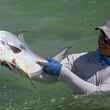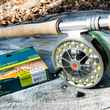Years of efforts by conservation groups such as Menhaden Defenders and the Pew Environment Group paid off late last week when the Atlantic States Marine Fisheries Commission (ASMFC) voted in the first ever protection measures for the tiny forage fish Atlantic Menhaden, commonly known as bunker. Bunker play a vital role in the marine ecosystem off the eastern coast of the United States, and advocates have warned for a long time that the reduction of their population could have catastrophic impacts on the entire food chain. In the days leading up to last Friday's historic vote, a myriad of advocacy groups and individual citizens delivered over 90,000 comments to the ASMFC in favor of placing protections on the number of menhaden that can be harvested from Atlantic waters. Their efforts paid dividends, as the ASMFC voted in protections that are expected to reduce the overall catch of bunker by 37%.
Specifically, the commission voted to set a harvest target of 30% of MSP (maximum spawning potential) as based on an unfished stock of menhaden. This new limit is to be achieved by 2013. The commission also voted to increase the overfishing threshold from 8% of MSP to 15%. This means that if the population of bunker falls below 15%, the population is considered overfished.



























